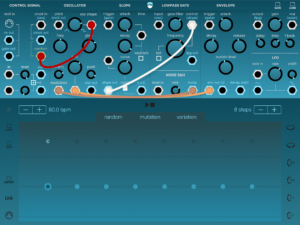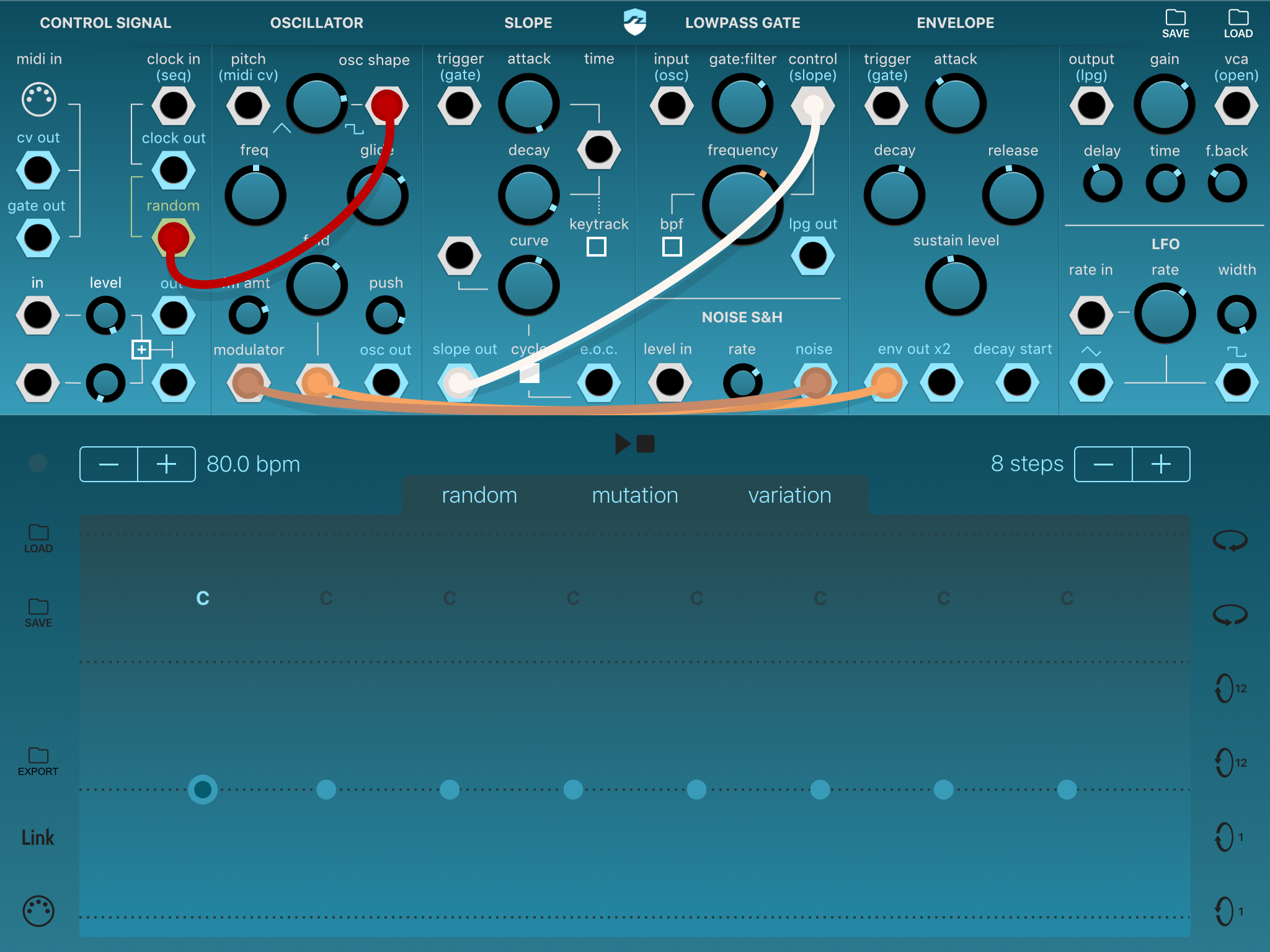Ripplemaker is the latest iOS music app from Ruismaker and developer, Bram Bos. Essentially a semi-modular synthesizer focused on West Coast techniques, consider Ripplemaker to be the tablet-based cousin of Make Noise’s excellent 0-Coast desktop synth. Suitable for the creation of drones and other sonic atmospheres of doom, this is another excellent product worthy of attention from any iOS musician.
Ripplemaker Features
- Easy to Use Semi-Modular Synth App
- Complex Oscillator, FM, Lowpass Gate, Slope Generator, Maths!
- Virtual Patch Cables Abound
- The Excellent Bram Bos Sequencer
- AU Plugin with a Small Footprint
- Support for Audiobus, Core MIDI, Virtual MIDI, Bluetooth MIDI
- Exports MIDI and Audio Files
- Universal App for both iPad and iPhone
- Available at the App Store for $8.99
If you have any level of interest in modular synthesis, Ripplemaker belongs in your iOS app collection. Its “single screen” interface is easier to grasp than other iOS modular synths. Check it out!
An iOS Modular Synth on One Screen
The fact Ripplemaker easily fits on one screen makes it easier to use than most other iOS modular synth apps, like Audulus and the Moog Model 15 – both of which I love. Empirical experimentation gets rewarded as virtual cables are easily dragged and dropped between patch points. While drones are one of the biggest selling points for Ripplemaker, the excellent Bram Bos sequencer – as seen in Troublemaker and other Ruismaker apps – is also part of the app when used in standalone mode.

Ripplemaker’s screen layout is somewhat reminiscent of the 0-Coast. From left to right are sections labeled Control Signal, Oscillator, Slope, Lowpass Gate, and Envelope, with an LFO and amplifier that also includes a delay. Color-coded jacks make wiring up patches an easier process. You are also able to break the normalized input jacks to build your own interesting sounds, while the normalized outputs are shareable with different inputs. Stack those virtual patch cables!
West Coast Synthesis on iOS
A West Coast synthesizer architecture lies at the heart of Ripplemaker. The basic oscillator is a triangle wave, while a voltage-controlled knob allows morphing into a square wave. Additional waveform complexities are generated using the wavefolder and push controls – the latter adding a DC offset. FM modulation – with multiple options for a modulator – rounds out the synth’s oscillator design.
The versatile slope generator is usable as an AD envelope, LFO, or another oscillator. The envelope is the default setting. Simply tap the “cycle” checkbox to switch it into LFO mode – this is somewhat similar to the 0-Coast. Tapping “keytrack” allows the same CV signal used for the main oscillator to control the slope frequency, with fine tuning allowed by the voltage controlled curve knob. Sonic possibilities abound.
A low pass gate circuit serves as Ripplemaker’s West Coast version of a filter combined with a VCA in the Buchla School way. The “gate:filter” knob emphasizes either the filter or the amplifier, and of course, it’s voltage controlled. The combined noise/sample and hold module only adds to the fun.
A standard ADSR envelope, with two discrete output jacks, adds to Ripplemaker’s architectural flexibility. This module also provides an output jack that sends a pulse when the decay starts. The amplifier and LFO dual module rounds out Ripplemaker’s architecture; a built-in delay helps push your sonic designs over the cliff as necessary.
Can-Utility and the Control Signals
Ripplemaker’s Control Signal module takes incoming MIDI information and converts it into the CV and gate signals used throughout the synth. A separate clock I/O helps keep the synth in sync. The utility section essentially serves as a maths module. It provides inputs, attenuators, and outputs with an add/multiply circuit used to blend both inputs – either a CV or an audio signal. It’s definitely useful.
Unlike Troublemaker, Ripplemaker allows for the saving of patches, albeit without Save As/Overwrite functionality. Granted, since it is an AU plugin many users take advantage of their iOS container app’s state saving functionality when designing patches. I primarily use iOS synths in standalone mode through a bunch of outboard effects before the audio ends up in ProTools, so in-app patch saving is helpful.
If you are interested in exploring West Coast modular synthesis without investing hundreds of dollars in hardware, Ripplemaker serves as a perfect introduction. With a simple and intuitive interface that rewards experimentation, it is a powerful and flexible synth without the complexity of other iOS modular synthesizers.




Comments
3 responses to “Review: Ripplemaker brings West Coast Modular Synthesis to iOS”
[…] with the architectural flexibility to foster new kinds of alien planetscapes. When also considering Ripplemaker, there’s no denying the iOS synth world now offers two top notch apps for designing ambient […]
[…] previously reviewed Ruismaker’s Troublemaker and Ripplemaker apps and the Rozeta suite is as essential as both. Once you establish a workflow in your favorite […]
[…] you read our previous reviews of Ruismaker’s products, you know about Bram Bos’s interface design skills. Kosmonaut might be […]